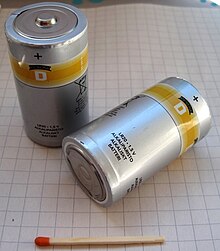AD battery (D cellorIEC R20) is a standardized size of a dry cell. A D cell is cylindrical with an electrical contact at each end; the positive end has a nub or bump. D cells are typically used in high current drain applications, such as in large flashlights, radio receivers, and transmitters, and other devices that require an extended running time. A D cell may be either rechargeable or non-rechargeable. Its terminal voltage and capacity depend upon its cell chemistry.

The National Carbon Company introduced the first D cell in 1898. Before smaller cells became more common, D cells were widely known as flashlight batteries. The U.S. military designation for this battery has been BA-30 since sometime before World War II.[1] During World War II, it was designated the Type C battery by the U.S. Navy, leading to confusion with the smaller C cell battery (BA-42).
In 2007, D batteries accounted for 8% of alkaline primary battery sales (numerically) in the U.S. In 2008, Swiss purchases of D batteries amounted to 3.4% of primary and 1.4% of secondary (rechargeable) sales.[2][3]

D batteries have a nominal diameter of 33.2 ± 1 millimeters (1.3 inches). The overall length is 61.5 millimeters (2.42 inches).[4]
| Zinc–carbon | Alkaline | Li-FeS2 | NiCd | NiMH | Li-SOCl2 | ||
|---|---|---|---|---|---|---|---|
| IEC name | R20 | LR20 | FR20 | KR20 | HR20 | ER? [citation needed] | |
| ANSI/NEDA name | 13D | 13A | 13LF | 13K [citation needed] | 13H [citation needed] | ||
| Typical capacity | milliamphours | 8,000 mAh | 12,000–18,000 mAh | 2,000–5,500 mAh | 2,200–12,000 mAh | 19,000 mAh | |
| energy | 12 Wh | 18–27 Wh | 2.5–6.9 Wh | 2.75–15 Wh | 68.4 Wh [citation needed] | ||
| Nominal voltage | 1.5 V | 1.5 V | 1.5 V | 1.25 V | 1.25 V | 3.6 V | |
| Rechargeable | No | Special type only | No | Yes | Yes | No | |
| Name / Type of this battery | Alkaline | Zinc–carbon | Li-FeS2 | Li-SOCl2 | NiCd | NiMH | |
|---|---|---|---|---|---|---|---|
| IEC name | LR20 | R20 | FR20 | ER? [citation needed] | KR20 | HR20 | |
| ANSI/NEDA name | 13A | 13D | 13LF | 13K [citation needed] | 13H [citation needed] | ||
A battery's capacity depends upon its cell chemistry and current draw. Duracell brand rates its alkaline D cell performance as approximately 20,000 mAh at 25 mA draw, but about 10,000 mAh at 500 mA draw.[5] This effect is generally less pronounced in cells with NiMH chemistry and hardly at all with NiCd. Many commonly available size D rechargeable cells are actually sub-C cells in a D-sized holder.